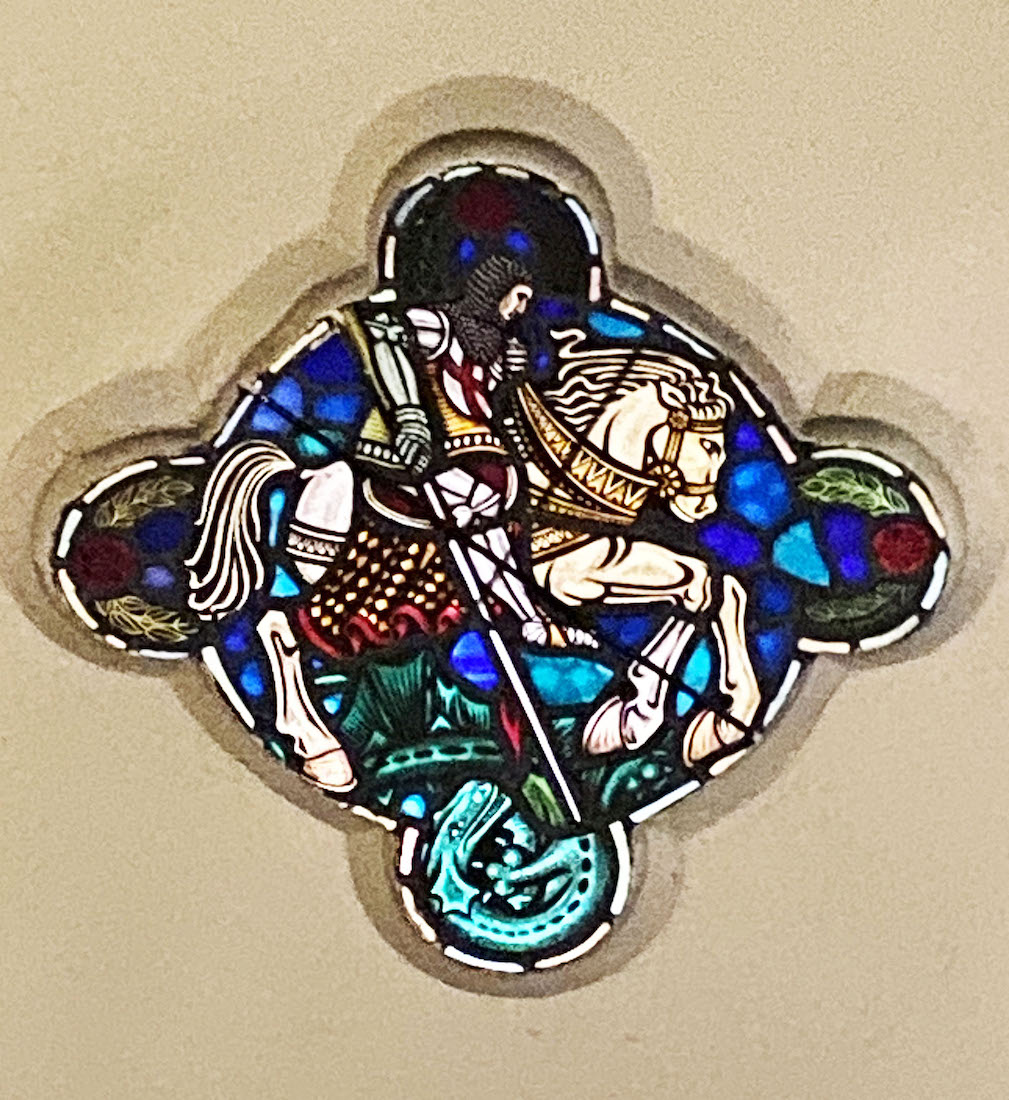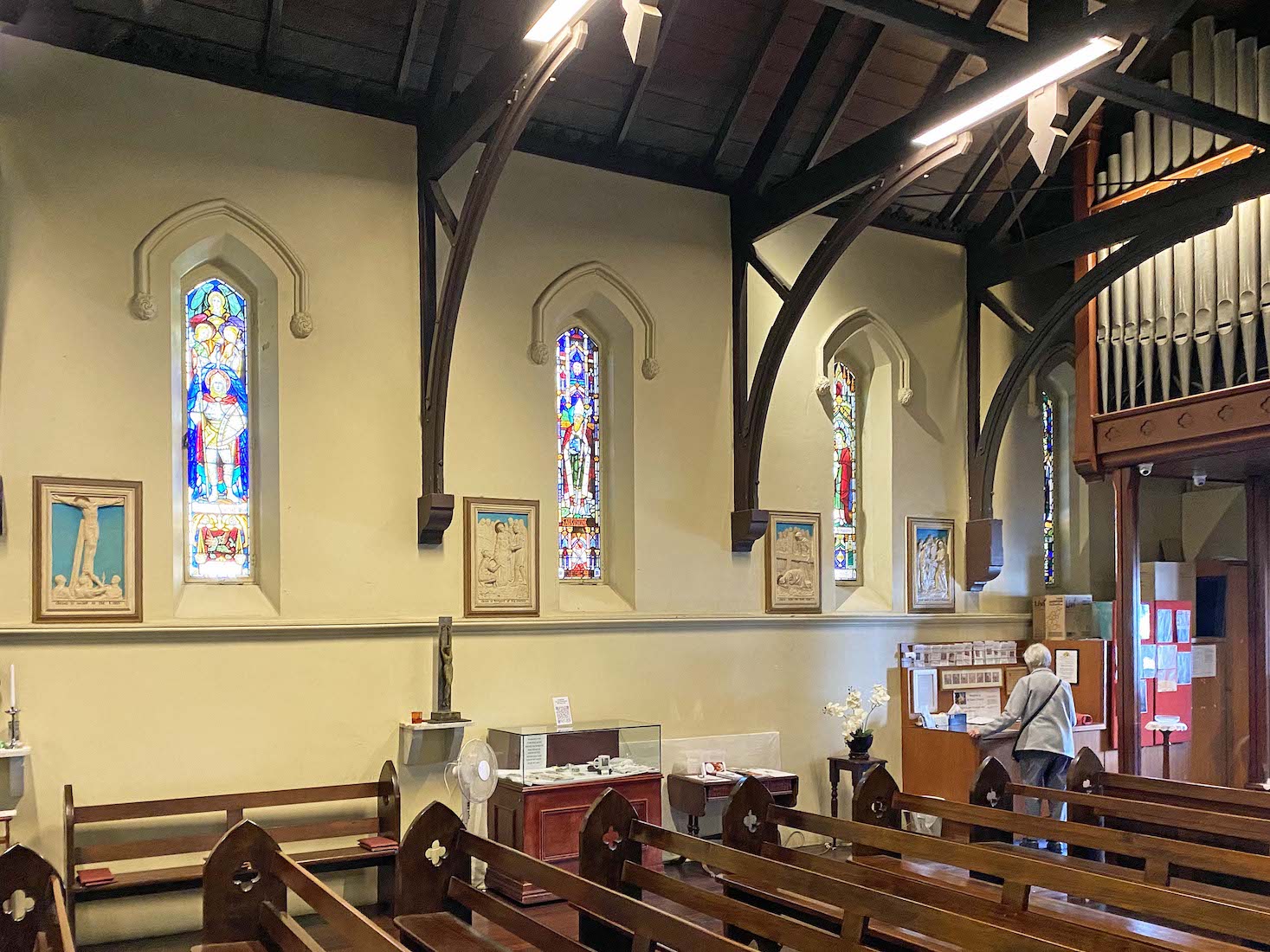
On the East wall of the sanctuary, under the window, is a high altar. All Saints has chosen not to follow the more modern practice of having a nave altar where the celebrant faces the congregation. Various candles stand on and around the altar as well as a covered tabernacle containing Elements of the Eucharist. INDEX
42. EAST WINDOW

Behind the high altar is the East window, depicting the crucifixion. At top is an image of the Risen and Glorified Christ. Below are two quatrefoils showing the first and last letters of the Greek alphabet – Alpha and Omega, alluding to the words of Christ in Revelation 22:13 – ‘I am Alpha and Omega, the beginning and the end.’ The bottom three lancets show Christ on the Cross, with his mother Mary at left, and disciple John at right. As indicated earlier, these are the oldest stained glass windows in Brisbane, installed in 1870.
43. SANCTUARY RECESS
On the South side of the sanctuary is a recess. I guess this serves the purpose of a retable: a place for standing items during the celebration of a service. The back wall of this niche is covered with cork perhaps? – matching the front panels of the altar.
44. ALTAR RAIL KNEELERS
Below the altar rail we find a row of kneeler cushions, most likely created by the ladies of the Church. The cushions display various religious symbols, and a row of text which is probably intelligible when all the kneelers are placed in order!
46. LECTERN AND MADONNA
The fine lectern was presented to the Church by Sir James Dickson in 1884. ••• The statue of Mary holding the Child Jesus is quite touching. Apart from Jesus holding an orb, the image speaks of poverty, hard work and a simple lifestyle.
47. CHAPEL WINDOWS
There are three stained glass windows in the Lady Chapel. ••• The window at left is on the front (East) wall of the Chapel and depicts the Assumption of Mary. ••• The remaining two windows on the South wall pick up on the theme of saints. Here are shown St Matthew (the Evangelist), and St Mark the Evangelist with his symbol of the winged Lion. Matthew and John are two of The Four Evangelists, responsible for the writing of the Gospels.
48. CHAPEL ALTAR
The Lady Chapel has a nicely carved wooden altar with Gothic arches across the front. At centre is the IHS logo with the first three letters of the name JESUS in Greek, decorated with bunches of grapes. We notice a very small Pietà to the left of the altar, and an icon hanging above.
49. PIETÀ AND ICON
The Madonna della Pietà (Our Lady of Pity) (1498–1499), informally known as La Pietà, is a life-sized marble sculpture of Jesus and Mary at Mount Golgotha representing the ‘Sixth Sorrow’ of the Blessed Virgin Mary by Michelangelo Buonarroti, now in Saint Peter's Basilica, Vatican City. ••• The icon on the wall is Thérèse of Lisieux OCD (1873 – 1897), also known as Saint Thérèse of the Child Jesus and the Holy Face. She was a French Catholic Discalced Carmelite nun who is widely venerated in modern times. She is popularly known in English as the Little Flower of Jesus, or simply the Little Flower.
50. NICHE AND EMBROIDERY
On the side wall of the chapel is a storage niche, and a framed embroidery of Mary holding her Child Jesus.
51. CHAPEL CHAIR AND LAMP
The Lady Chapel contains this very interesting old chair, and has its own sanctuary lamp.
52. CHAPEL MEMORIALS
Finally, we notice two memorial plaques on the South wall of the Chapel. The upper plaque remembers Private Benjamin Andrew Acreman who died in active service in 1915. The lower plaque remembers Annabella Campbell Morehead (1848 – 1890) who worshipped in this Church. We now leave the Lady Chapel.
53. SOUTH NAVE
This wall has a row of stained glass windows, as well as various Stations of the Cross which we have already investigated. There are some further items of interest below.
54. SOUTH NAVE WINDOWS I
The first three windows depict: ••• St Thomas of Canterbury. Thomas Becket (1119 – 1170), served as Lord Chancellor and then as Archbishop of Canterbury from 1162 until his death in 1170. He engaged in conflict with Henry II, King of England, over the rights and privileges of the Church and was murdered by followers of the King in Canterbury Cathedral. ••• St Edmund, King and Martyr. Little is known of St Edmund who was King of East Anglia from about 855 until his death in 869. Pictures of his death indicate that he died of many arrows. ••• This photograph is a failure, and I would greatly appreciate receiving an improved version! I have no idea of the saint depicted here.
55. BLACK MADONNA AND CHILD
Near the Lady Chapel, and below the window level, we come to a Black Madonna and Child. The term Black Madonna or Black Virgin tends to refer to statues or paintings in Western Christendom of the Blessed Virgin Mary and the Infant Jesus, where both figures are depicted with dark skin. Examples of the Black Madonna can be found both in Catholic and Orthodox countries.
56. ST ANTHONY, CRUCIFIXION AND MONK
Following along the South wall we next come to a statue of St Anthony of Padua (1195 – 1231). He was a Portuguese Catholic priest and friar of the Franciscan Order. He is often remembered by a story of the Christ Child appearing to him as he meditated on a book. ••• Next is a painting of the crucifixion, and then there is the figure of a monk. ••• The monk is Padre Pio, in full Pio of Pietrelcina, born as Francesco Forgione, (1887 –1968), who was an Italian Capuchin friar, priest, stigmatist, and mystic. He is venerated as a saint in the Catholic Church.
57. SOUTH WALL WEST
The remainder of the South wall extends before us, leading us back to the door we came in by. Here there are four more stained glass windows.
58. SOUTH NAVE WINDOWS II
There is no problem identifying the saints depicted in these windows. From left we have: ••• St Michael is the best known of the archangels – or chief angel. It is unclear why Michael is given the title of ‘saint’. ••• Augustine of Hippo (354 – 430), also known as Saint Augustine, was a theologian and philosopher of Berber origin and the bishop of Hippo Regius in Numidia, Roman North Africa. His writings influenced the development of Western philosophy and Western Christianity, and he is viewed as one of the most important Church Fathers. ••• Mary Magdalene was a woman who, according to the four canonical gospels, traveled with Jesus as one of his followers and was a witness to his crucifixion and resurrection. She is mentioned by name twelve times in the canonical gospels, more than most of the apostles and more than any other woman in the gospels, other than Jesus’ family. Mary’s epithet Magdalene may be a toponymic surname, meaning that she came from the town of Magdala, a fishing town on the western shore of the Sea of Galilee in Roman Judea. ••• St Alban is venerated as the first-recorded British Christian martyr. He was said to have been protecting a priest, and is believed to have been beheaded in Verulamium (modern St Albans) sometime during the 3rd or 4th century.
59. SHRINE
Next along this South wall is this shrine, but I have no information about this.
60. ITEMS FOR SALE
Close by the shrine is a glass cabinet with various religious items for sale.
61. SIDE AISLES
This completes our investigation of the All Saints Anglican Church, so we just step back to take an over-view: here looking down the two side aisles. [Photo Credits: All Saints Walkinto]
62. FINAL VIEW
And finally, a view down the central aisle – the same view as when we first entered the Church, but now seen with a greater appreciation of this sacred space.

CONCLUSION
I hope you have enjoyed visiting All Saints Anglican Church, Brisbane with me. This is such an interesting old church, and easy to visit from Brisbane’s city centre.
I am happy to receive constructive comments or corrections concerning this website. The best websites are the ones which have no errors! I am grateful to my wife Margie who came to Brisbane with me, and who has proof-read these pages.
All but three of the photographs on this site are mine. The exceptions come from a ‘walk through’ presentation, and are acknowledged in the text.
The text comes from a variety of sources: I mention in particular the ever-faithful Wikipedia.
All Saints Anglican Church has its own website. The link is
https://www.allsaintsbrisbane.com
The photographs which appear on this site can also be found in higher resolution at:
https://www.flickr.com/photos/paulscottinfo/albums/
Paul Scott Site created 08 / 23
paulscott.info@me.com



































